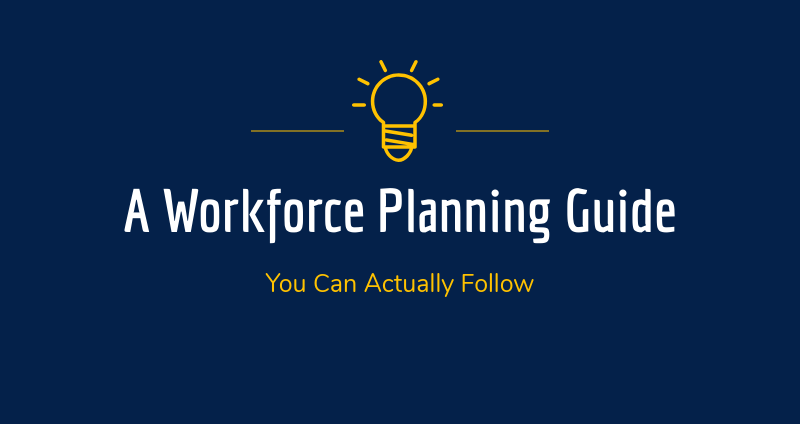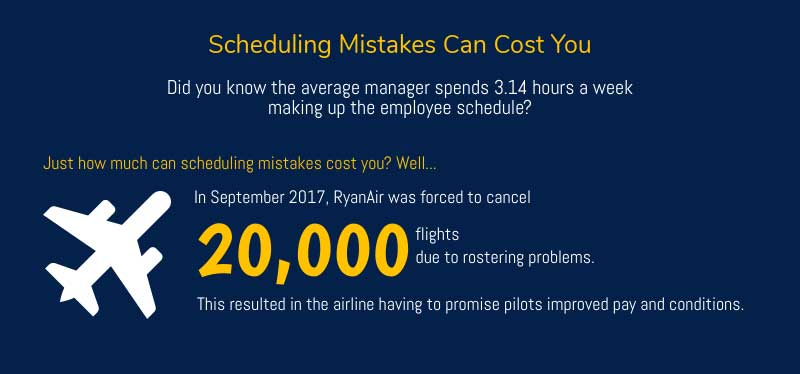Scheduling, time & attendance, task management, and day-to-day HR management are the building blocks of every business. Every business is idiosyncratic so there is no single ‘best’ way to manage these processes; however, each business can utilize several planning techniques to ensure the most efficient outcomes.
This in-depth workforce planning guide has been designed to straighten out any misconceptions behind workforce planning and management and will hopefully inspire you to build your new workforce planning process today.
Curated with business leaders, employees, and anyone working in the HR and recruitment industry in mind, this guide outlines what exactly workforce planning is and what the process involves, some key workforce planning techniques, the benefits behind strategic workforce planning, potential workforce issues, as well as how to best utilize workforce management software during the planning process.
Contents
- Your Workforce Planning Goals
Workforce Planning: Recruitment and Talent Management
- Forecasting
- Seasonal Workforce Planning
- Upskilling and Talent Management
- Employer Reputation
Workforce Planning: Staff Scheduling and Rostering
- Team Balance
- Labour Budget
- Worker Availability
- Outsourcing
- Schedule Communication
Workforce Planning: Time & Attendance
- Recording Attendance
- Data Management & Verification
- Reporting
- GDPR
- Map Your Workflows
- Shopping for a Vendor
- implementation and Onboarding
Your Workforce Planning Goals
To start, you will need to define and prioritize your business goals and build your workforce planning process around achieving those goals.
There are obvious ideals, such as regulatory compliance; employee satisfaction/productivity; workflow efficiencies and resulting cost savings; reduction of administration errors etc. but you must define your goals specifically around your business model and what you ultimately hope to achieve.
Food for thought:
- How can you plan your workplace environment around how you position your brand?
- How do your efforts to increase efficiency improve/deteriorate your relationships with client/employees/colleagues?
Workforce Planning: Recruitment and Talent Management
At the base of your workforce plan is an effective and systematic recruitment process ensuring that your business’s operations can respond quickly to the market.
Forecasting
Constant changes in the market, as well as changes in upcoming trends can sometimes leave a company in a bit of a difficult state. Workforce forecasting is designed to help develop a strategy to improve your company and to help establish a direction for your future employees. As a corporate organization, you need to always be establishing the next steps. Looking towards the future for both management and the rest of your team can encourage effective planning which will positively impact the company.
Food for thought:
- Do you have the labour force to respond to changes in business goals? Eg. new business models, new initiatives, or reorganizations.
- Can you prepare for changes in the market such as labour supply, revenue shortfalls, or changes in workforce demographics?
- How do you stay aware of potential changes in the external environment such as demand for workforce maintenance and enhancement such as retirement, regular training and performance planning?
Allowing for change and spotting workforce trends within a specific industry, is part of the planning process and will really help your business to thrive during the recruitment process. According to the 2017 State of Workforce Management Report, ONE in THREE organizations experience a turnover rate of over 20% in the Health and Human Services sector:
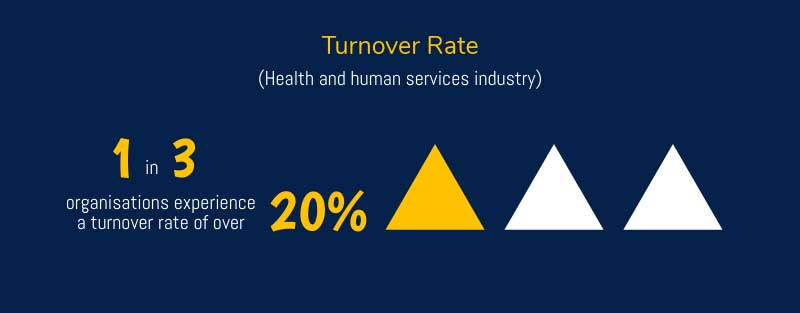
Seasonal Workforce Planning
Related to forecasting, some businesses will need flexible workforce plans to enable them to respond to recurring seasonal peaks and troughs. Many businesses can quickly scale up/down by utilizing fixed-term or zero-hour contracts, but any rapid recruitment drive will require significant forethought and systematic implementation.
Food for thought:
- Do you a sufficient pipeline of workers to feed into any increased demand?
- Are you conscious of compliance issues for zero-hour contracts and agency worker regulations?
Upskilling and Talent Management
Ensuring that you have sufficient people power to respond to market changes is one thing, making sure that you have the right blend of people is another. To effectively plan your workforce, it is always wise to consider the skill profiles of each recruit and to include the right blend of experience and freshness into your thought. This will ensure that less-experienced are upskilled quickly, and experienced workers are consistently challenged by fresh faces.
Food for thought:
- Do you include training programs for your employees?
- Do you have a succession plan for specific high-value employees?
Employer Reputation
More and more, businesses need to be conscious of their reputation as an employer to ensure that they can adequately respond to market changes. Brand reputation feeds into this as people will want to work with a business that they recognise to be successful. However, savvy potential recruits will be aware of the workplace environment before accepting a position and any effective workforce plan will include initiatives to maintain an attractive workplace.
Food for thought:
- Are you aware of how your current employees feel about their day to day work experience?
- How do you drive current and former employees to share their positive experiences online?
Workforce Planning – Staff Scheduling and Rostering
Scheduling/rostering your workforce is a key area to exploit when constructing a good workforce plan as there are so many areas to gain more efficiencies.
Team Balance
Each roster benefits from not only having the right person, at the right place, at the right time; it also needs to ensure that the right people are working together. Like getting the right balance of experience when recruiting your workforce, you will need to also get the right balance of experience, personality, and skills when rostering to ensure your business effectively operates according to your various goals.
Food for thought:
- Do you consider personal relationships when building your roster? i.e. do certain people work better with others?
- Would you benefit by allowing your employees to select who they work with?
- Will certain employees benefit from being re-assigned?
Labour Budget
If you employ staff by the hour, additional consideration will be made to your staffing budget when planning your workforce’s schedule. Some business’s may directly relate who they need to the revenue that is expected on a given day. However, some businesses do not always benefit from predictable daily income or their goals may be broader than making a profit on a given day.
Food for thought:
- What will be the costs of being under-staffed on a project?
- Are you in a position to schedule ‘on-call’ staff?
Worker Availability
Not every worker is available all the time, so each workforce plan will incorporate a method for communicating availability clearly, so schedules can be produced quickly without having to make last minute changes because someone can’t attend.
Food for thought:
- Have you given enough time in advance for staff to communicate if they are unavailable to work?
- Are you able to quickly assess if you have adequate cover should a specific employee requests time off?
Outsourcing
How you schedule temps can be an essential part of your workforce plan, so you can ensure that you are effectively communicating with staff not familiar with your business processes and how you manage your relationship with your staffing agencies.
Food for thought:
- Are you considering agency worker regulations when allocating temps to your roster?
- Have you considered streamlining how your staffing suppliers respond to your need for temps?
Schedule Communication
Working within management or the HR industry, you should never underestimate the importance of effective communication. Having a streamlined communication platform for your staff is essential within the workforce planning process. Having a staff network or ‘portal’ is beneficial for advertising new projects and events, as well as quickly confirming a specialist team for any future project.
Food for thought:
- Do you have accurate contact information for each staff member?
- Are your staff ‘mobile-friendly’? i.e. can you communicate with them via smartphone apps?
Carrying out strategic staff scheduling and rostering will help to ensure that your business avoids any unexpected costs due to scheduling mistakes and avoid being another RyanAir:
Workforce Planning – Time & Attendance
The result of a good workforce plan is; the work was done – everyone got paid. Apart from this obvious benefit, a good time & attendance strategy will also give accurate records for security, compliance, and legal benefits.
Recording Attendance
There is no silver bullet for an accurate time & attendance system, however most static workplaces will invest in a clock in/out system for digitally tracking hours on site. There’s a variety of options in this area from biometrics, to old-school ID cards. For mobile workers, it has been more difficult to get accurate records, but there are a growing number of solutions available that are making this less challenging. Whether it’s through mobile apps using GPS based clock in systems, or client/manager operated digital sign in sheets, there’s no reason why businesses cannot get complete, accurate attendance records whatever the workplace environment.
Food for thought:
- Have you considered the profile of your workforce when considering which time & attendance solution is most suitable?
- What are your policies for flagging errors, omissions, and ‘clock-in’ fraud?
When it comes to recording attendance for shifts and events, employee illness will play a vital role. The below chart outlines that from a report by Health and Safety Executive in 2016/17, there were 31.2 million working days lost due to work-related ill health and non-fatal workplace injuries:
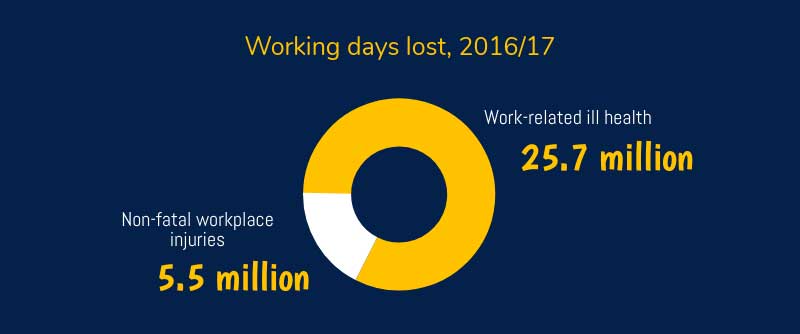
“Stress, depression or anxiety and musculoskeletal disorders accounted for the majority of days lost due to work-related ill health, 12.5 million and 8.9 million respectively.
On average, each person suffering took around 17 days off work:
- 9.1 days for injuries
- 19.8 days for ill health cases
- 23.8 days for stress, depression or anxiety
- 17.6 days for musculoskeletal disorders.”
Data Management & Verification
Once you’ve recorded shift attendance, there are some more steps that should be considered prior to sending the data to your payroll department; chief among them is the process of verifying the accuracy of the attendance records. Transparency is key here; giving clients, managers, supervisors, and staff the ability to review and approve of the recorded work hours will guarantee that all the data is accurate – making sure there’s nothing to complain about once everyone gets paid.
Food for thought:
- Who should get the final approval on hours worked?
- How can you make the process as transparent as it needs to be for it to be adequately efficient and accurate?
Reporting
After all the attendance information has been recorded and verified, you are in a position to run reports. Primarily, you’ll be able to run reports to assist with your payroll and billing process, but you’ll also be able to run accurate reports for analysis on work that has been done to compare it with the performance of your business. Insights during this process are crucial for feeding back into your workforce plan.
Food for thought:
- Do you need to transfer your attendance data to other systems? Is the data formatted correctly for import or can you utilize API technology?
- What qualitative insights can you get from your reports? Assess if you need to record more data during the earlier stages for better insights.
Workforce Planning Tools
Every business will plan differently in terms of recruitment, scheduling, communication, and time & attendance tracking, therefore there is no one-size fits all solution for managing each workflow. However, all businesses will likely invest in software for managing some, if not all, of these workflows.
GDPR
The General Data Protection Regulation (GDPR) is part of the EU Data Protection Regulation and will be replacing the current Data Protection Directive. The new regulation is designed to standardize and strengthen the rights of European citizens when it comes to their data privacy. With the GDPR coming into effect as of 25th May 2018, it’s crucial that you consider how any changes to how you plan your workforce maintains compliance with this new regulation. It is also important to understand the role of any software vendor’s compliance as data processors before deciding to implement.
Food for thought:
- Have you appointed a Data Protection Officer and completed an audit of how you control your employee data to ensure compliance?
- Have you considered consolidating where you host employee data to reduce the burden of holding data in multiple disparate systems?
Map Your Workflows
Before investing, you should design a model of your workforce plan, map the various processes and how each team member currently engages with each process. The point of this investigation should be to identify the key inefficiencies in your workforce plan, and whose workflows will be most impacted by a change in process.
Food for thought:
- What external benefits will you get from making drastic changes to your business’s workforce operations? What costs will be incurred in making these changes?
- Who will be impacted most in a change of workflow? Are they involved in the decision process?
Using strategic workforce planning can help you map those business goals and gain an idea of what lies ahead for your business. Did you know that 61% of employers expect to hire more people in 2018 than they did in 2017? Indeed surveyed 1,000 employers to see how they’re feeling about employment in 2018:
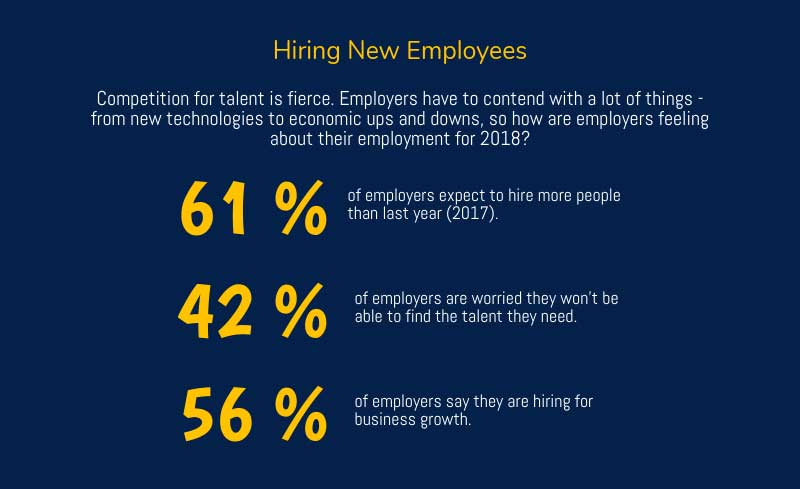
Shopping for a Vendor
Workforce planning tools of every kind are readily available online, but it would also be worthwhile to find what is working best for your industry in your area. Most software vendors offer free trials or freemium versions for you to get to grips with how they manage various processes, giving you ample opportunity to assess if they align with your business’s workflows. Speak with each vendor you are assessing to allow them to get to grips with your goals and have them pitch how their solution is viable – not everything will be obvious during the trial so be sure to get a demonstration for the bigger picture.
Food for thought:
- How involved would you like your operations and admin team to be in the shopping stage?
- Have you been able to go through a ‘live’ trial (i.e. assessing the solution against your ideal workforce plan)?
Implementation and Onboarding
There is very rarely a quick switchover when an ideal solution has been identified. Getting any new process embedded quickly requires a quality onboarding strategy from the vendor and investment from each stakeholder. Prior to deciding on a vendor, it would be useful to assess what their onboarding process is like, what their experience is with your industry, and how much resources they will dedicate to training. You will also be best served by projectizing the implementation and appointing an internal project manager that is dedicated to a smooth transition.
Food for thought:
- How adaptable are your operations and administration team? Are they invested in the project?
- What sacrifices is your team making to their workflow to embedding a new solution? Will this cause ill-feeling towards the success of this project?
Conclusion
Seeking to develop workforce planning processes? Whatever your staffing volume and whether you work in resourcing and recruitment, business management or talent management, we hope this guide acts as a useful resource and has provided an overview of workforce planning strategies, workforce requirements, as well as the stages involved when putting a system into place. This guide has been developed to provide information on some of the main elements of workforce planning but please feel free to get in touch with one of our professionals here at uTRAC, if you’d like any further information or advice.
